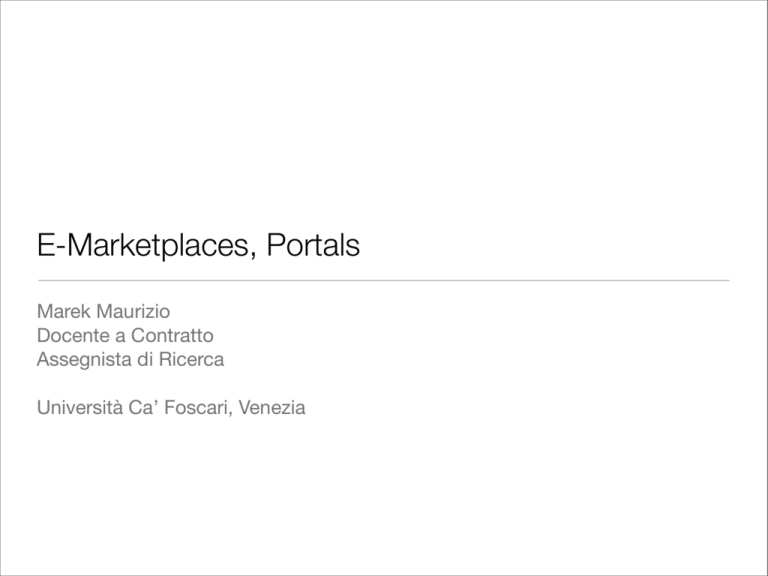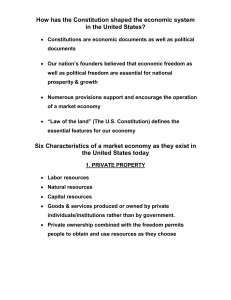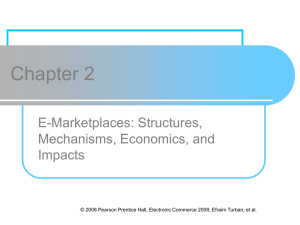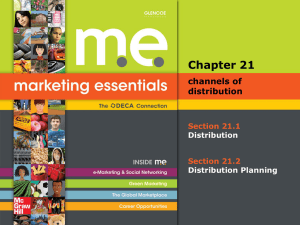02 - e-marketplaces
advertisement

E-Marketplaces, Portals Marek Maurizio Docente a Contratto Assegnista di Ricerca Università Ca’ Foscari, Venezia Learning Objectives • Define e-marketplaces and list their components. • List the major types of e-marketplaces and describe their features. • Describe the various types of EC intermediaries and their roles. • Describe electronic catalogs, shopping carts, and search engines. • Describe the major types of auctions and list their characteristics. Learning Objectives • Define m-commerce and explain its role as a market mechanism. • Discuss competition in the digital economy. • Describe the impact of e-marketplaces on organizations and industries. Bluenile.co.uk Case of Study E-marketplaces The Emerging Role of Electronic Marketplaces on the Internet Yannis Bakos* Communications of the ACM, August 1998 Marketplaces Internet-based electronic marketplaces leverage information technology to match buyers and sellers with increased effectiveness and lower transaction costs, leading to more efficient, “friction-free” markets. 1. Functions of a Market Markets play a central role in the economy, facilitating the exchange of information, good, services, and payments (Bakos 1998). Markets play a central role in the economy, facilitating the exchange of information, goods, services and payments. In the process, they create economic value for buyers, sellers, market intermediaries and for society at large. Recent years have seen a dramatic increase in the role of information technology in markets, both in traditional markets, and in the emergence of electronic marketplaces, such as the multitude of Internet-based online auctions. Markets (electronic or otherwise) have three main functions, summarized in Table 1: (a) matching buyers and sellers; (b) facilitating the exchange of information, goods, services and payments associated with market transactions; and (c) providing an institutional infrastructure, such as a legal and regulatory framework, that enables the efficient functioning of the market. In a modern economy, the first two functions are provided by intermediaries, while the institutional infrastructure is typically the province of governments. Internet-based electronic marketplaces leverage information technology to perform the above functions with increased effectiveness and reduced transaction costs, resulting in more efficient, “frictionfree” markets. * Stern School of Business, New York University. Email: bakos@stern.nyu.edu; Web: http://www.stern.nyu.edu/~bakos Marketplaces - II • Three functions for markets (both real and electronic): • matching buyers and sellers • facilitating the exchange of information, goods, services, and payments associated with market transactions • providing an institutional infrastructure, such as a legal and regulatory framework, that enables the efficient functioning of the market Functions of a Market • In later years markets have seen a dramatic increase of IT and EC use E-Marketplaces (or marketspaces) • Online marketplace (or online ecommerce marketplace) refers to a type of ecommerce site where product and inventory information is provided by multiple third parties, (whereas transactions are processes by the marketplace operator) [wikipedia.org] • Greater information richness • Lower search costs for buyers • Less information asymmetry • Buyers and sellers can be in different locations Marketspaces • Major components of a marketspace: • Customers • Sellers • Products • Infrastructure • ... Marketspaces - II • ... • Front-end • Back-end • Intermediaries • Support services Customers • Millions of people surfing the web • search for detailed information • compare • place bid, buy (digital) objects Sellers • Millions of storefronts are on the Web • Huge variety of products and services • Sellers can sell directly on their website or from e-marketplaces Products and Services • In marketspaces it is possible to commerce in digital products and services • Both type of markets can sell physical products • Marketspaces can sell digital products, that can be delivered over the Internet • With digital products most of the costs are fixed, and variable costs are very low • Profit increase very rapidly as sales volume increase Examples of digital products in 2006! Infrastructure • The marketspace infrastructure includes electronic networks, hardware, software, etc Front-End • The portion of an e-seller’s business processes through which customers interact, including the seller’s portal, electronic catalogs, a shopping cart, a search engine, and a payment gateway Back-End • Back end: The activities that support online order-taking. It includes fulfillment, inventory management, payment processing, packaging, and delivery Intermediary • A third party that operates between sellers and buyers • Online intermediaries create and manage the online market. • They help match buyers and sellers, provide some infrastructure services, and help customers and/or sellers to institute and complete transactions Essential Elements Types of E-Marketplaces - Storefront • A storefront refers to a single company’s website where products and services are sold • May belong to manufactures, retailers, or to individuals • Several components necessary to carry out the sale: electronic catalog, search engine, shopping cart, payment gateway, shipment, customer service Storefront Example - Raffles Hotel (Singapore) Types of E-Marketplaces - E-Mall • An online shopping center where many stores are located • Different types of malls • Simply a directory • Shared services Expedia.com Shared services Types of Stores and Malls • General (amazon.com) • Specialized (1800flowers.com) • Regional (parknshop.com) VITASOY SB MILK 250ML CASE 4X6SX250ML HUGGIES NC BABY WIPES REFILLED 144'SX3 MAS BELLES EAUX LES COTEAUX 75CL MASTERS PURA FRESH MILK-3 BOTTLES 1LX3 DOWNY ULTRA FABRIC SOFTENER APRIL FRESH-REFILL 34OZX3 CH MARTINET SAINT EMILION 2005 75CL SCOTT ECONOMY 3 PLY BATHROOM TISSUE 10'SX4 MARUSAN SOYA DRINK LOW CALORIE 3PACK 1L X3'S FIRST PRESS NAPA CABERNET SAUVIGNON 75CL HK$63.60 $57.00 HK$77.00 HK$89.90 PARKnSHOP, a division of A. S. Watson Group (HK) Limited (a BVI company) HK$110.00 HK$150.00 HK$56.90 HK$179.00 $138.00 HK$179.00 $168.00 HK$179.00 $168.00 Information Portals (aka enterprise portal) • A portal is a mechanism used in e-marketplaces, e-stores, etc. • A portal is an information gateway • it enable people to search and access relevant information from disparate systems and the Internet • many portals can be personalized by the users Information Portals - II • Commercial Portals: the most popular type on the Internet, broad audience, diverse communities, personalization • Corporate Portals: organized access to a narrow set of company and partners informations • Publishing portals: communities with specific interests, little customization, great search • Personal Portals: narrow content very personalized • Mobile Portals: portals accessible from mobile devices • Voice Portals: portals with audio interfaces History of information portals [wikipedia] • The mid-1990s saw the advent of public Web portals like AltaVista, AOL, Excite, and Yahoo!. These sites provided a key set of features (e.g., news, e-mail, weather, stock quotes, and search) that were often presented in self-contained boxes or portlets. Before long, enterprises of all sizes began to see a need for a similar starting place for their variety of internal repositories and applications, many of which were migrating to Web-based technologies.[2] • By the late 1990s, software vendors began to produce prepackaged enterprise portals. These software packages would be toolkits for enterprises to quickly develop and deploy their own customized enterprise portal. The first commercial portal software vendor began to appear in 1998. Pioneers in this marketing included "pure play" vendors like Epicentric, Plumtree Software and Viador. The space, however, quickly became crowded by 2002, with the entry into the market of competing product offerings from application server vendors (such as BEA, IBM, Passageways, Oracle Corporation and Sun Microsystems), who saw portals as an opportunity to stave off the commoditization of application server technology, and Business Intelligence vendors such as Liferay portal. Enterprises may choose to develop multiple enterprise portals based on business structure and strategic focus while reusing architectural frameworks, component libraries, or standardized project methods (e.g. B2E, B2C, B2B, B2G, etc.). • In 2003, vendors of Java-based enterprise portals produced a standard known as JSR-168. It was to specify an API for interoperability between enterprise portals and portlets. Software vendors began producing JSR-168 compliant portlets that can be deployed onto any JSR-168 compliant enterprise portal. The second iteration of the standard, JSR-286, is final-released on 12 Jun, 2008. Publishing Portal Example www.zdnet.com Advanced Search Language Tools Google Search I'm Feeling Lucky Change theme from Purple Apple | Add stuff » Home Fantascienza.com Slashdot AsiaMedia Fantascienza.com Slashdot SlashGear La realtà dentro l'inquadratura Notizie: Thor è arrivato sulla Terra iSpazio - Notizie su i... Didattica indiana MacRumors : Mac N... Adoor Gopalakrishnan Notizie: Mass Effect 2 e 1/2 per Ps3 Il Fatto Quotidiano CSS-Tricks Matteo Spinelli's Cu... CSS3 Wizardry Tutorialzine AsiaMedia Updates Friends Tutorialzine Client Testimonials Powered by PHP, XML and jQuery How to Create a jQuery Confirm Dialog Replacement Coding a Rotating Image Slideshow w/ CSS3 and jQuery Notizie: Sam Neill ad Alcatraz, mentre The Event si complica CSS-Tricks Google Donates Windowbuilder, Codepro To Eclipse FBI Defend Raids On Texas Datacenter Nigerian Email Scam Victim Sues Bank, Loses Appeal iSpazio - Notizie su iPhone 4 in WebKit Image Wipes The Hacktastic Zoom Fix Italia, iOS 4, iPhone 3GS, iPod Touch, iPad Italia e recensioni App Store. The lean, mean, CSSreset machine. EasyTrails GPS: Ecco tutte le novità della versione 4.2 Enable chat Il Fatto Quotidiano La fobia degli arresti di Gasparri Scontri Roma: “Sono io ad aver colpito il quindicenne con il casco” Nuove immagini sull’aggressione al quindicenne MacRumors : Mac News and Rumors Apple Prepping for iWork '11 Mac App Store Launch? Apple's iOS Engineering Jobs Emphasize Navigation Software Experience Personal Portal Example iPad News Publication 'The Daily' Now Rumored for MidJanuary Launch Apps Builder: Crea la tua applicazione iPhone o iPad online in 3 passaggi! SlashGear www.google.com/ig CSS3 Wizardry CSS Gradients for IE9 Solo per oggi e fino alle 18:00 Vodafone offre la Mobile Internet ad 1! a settimana per 1 anno! Matteo Spinelli's Cubiq.org Nexus S UK price-drop confirmed as launch slips to December 22 Wireless carriers eye Mobile Portal Example www.google.com/ig on Safari Mobile Intermediation Intermediation in E-Commerce • Intermediaries (brokers) provide value-added activities and services to buyers and sellers • Infomediaries: electronic intermediaries that provide and/or control information flow in cyberspace, often aggregating information and selling it to others • The infomediary business model recognizes that there is value in this personal data and the infomediary seeks to act as a trusted agent, providing the opportunity and means for clients to monetize and profit from their own information profiles. One of the first focused implementations of the infomediary concept was an online advertising company called AllAdvantage. (Source: Wikipedia) Note • AllAdvantage was an Internet advertising company that positioned itself as the world’s first "infomediary" by paying its users/members a portion of the advertising revenue generated by their online viewing habits. It became most well known for its slogan "Get Paid to Surf the Web" a phrase that has since become synonymous with a wide array of online ad revenue sharing systems (see, e.g., paid to surf). (Source Wikipedia) does not exist anymore (www.alladvantage.com in 2011) Detour: Pay for Surf • Pay to surf is a business model that became popular in the late 1990s, prior to the dot-com crash. Essentially, a company uses income from advertising placed on members' screens to pay them for time spent surfing. • A pay-to-surf company would provide a small program, commonly called a "viewbar" • Advertisers' banner ads were then displayed while the member was browsing the web. Since the viewbar tracked websites that the user visited, the pay-tosurf company was able to deliver targeted ads for their advertisers. • Advertisers paid the pay-to-surf company a small amount (typically US$0.50) for every hour of a member's surfing. Una pay-for-surf italiana: NetFraternity • Pay for surf classica • Declino nel maggio 2001, prima offre solo crediti per uno store online, poi richiede la navigazione tramite il loro provider personale (a pagamento) • Dura lotta con spammer e cheater • http://www.repubblica.it/online/tecnologie_internet/paytosurf/netfraternity/ netfraternity.html Netfraternity Netspot on guadagnando.com 75 pixels + floating window Roles of Intermediaries • Intermediaries can address the following five important limits of direct interaction: • Search costs: by predicting demands or matching consumers with sellers • Lack of privacy: by protecting some information about the trade • Incomplete information: by providing additional information on the product or service sold • Contract risk: by reducing risks of non-payments, publicize bad behavior, holding payments until transaction is complete Disintermediation and Reintermediation • Disintermediation: Elimination of intermediaries between sellers and buyers • two types of intermediaries: the first provides information, the second add value • the first can be eliminated (airlines sell tickets online instead of using agencies) • Reintermediation: Establishment of new intermediary roles for traditional intermediaries that have been disintermediated, or for newcomers • new intermediary roles can arise from disintermediated businesses Market Mechanisms Electronic Catalogs • Electronic Catalog: the presentation of product information in an electronic form: the backbone of most e-selling sites • Objective: advertise and promote products and services • Quick search with search engines • Early online catalogs were replica of the printed catalogs • They evolved, and become integrated with shopping charts Electronic Catalogs Classification • Electronic catalogs can be classified by the following dimensions: • The dynamics of the information presentation • The degree of customization • Integration with business processes Paper and Online Catalog Comparison Search Engines • A computer program that access a database of Internet resources, search for specific information, and report the results. • Semantic search Shopping Carts • Order processing technology to accumulate items they wish to buy • B2C shopping carts are simple, B2B can be more complex • Many software implementations Summary • E-marketplaces and their components • The role of intermediaries • The major types of e-marketplaces • Overview of catalogs, search engines, shopping carts









